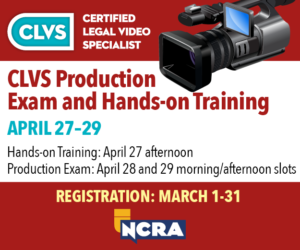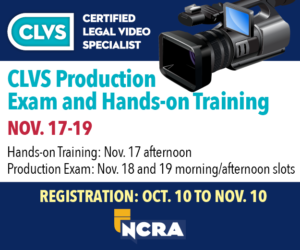 The Realtime and Technology Resource Committee is taking your questions on topics surrounding realtime and technology. Send the questions you want the Committee members to tackle to jcrfeedback@ncra.org.
The Realtime and Technology Resource Committee is taking your questions on topics surrounding realtime and technology. Send the questions you want the Committee members to tackle to jcrfeedback@ncra.org.
Dear Techie:
I am a court reporter who freelances with several different court reporting agencies. My trusty laptop is on its last legs, so I am going to purchase a new computer and will use my existing machine for backup purposes.
One of my upcoming assignments is a jury trial — a first for me. The courtroom is in an old courthouse and so I am unsure about the acoustics and whether I will be able to hear all of the participants. The voir dire is scaring me to death, actually. There will be no microphones for prospective jurors. I need my backup media to be as clear as possible.
Yikes! Please help! I need some guidance about which microphone options I should be considering.
Muddled Mike
Dear Mike:
Good luck on your upcoming assignment. It’s always good to go in prepared to handle anything. Here are a few recommendations from some of the Committee members.
Myrina Kleinschmidt, RMR, CRR, CRC, a freelancer and agency owner in Wayzata, Minn.: I have used many great microphones. Now I am using the SoundTech CM-1000 3.5 mm Omni-directional Conference Microphone. I use the SoundTech to connect to my separate recorder (Marantz Professional, which is plugged into a power strip). I have connected up to three via daisy chaining down a long conference table. There’s a USB version if you want to connect to a computer and then daisy chain more from there. The microphone costs about $39.
I currently use CaseCat and DigitalCAT, and I have a Dell Latitude; but I do not use a microphone with my computer at this time. In the past, I used the DepoBook Stealth Microphone and that was a plug and play, which worked well with my Latitude. Since all software and computers have different audio systems, it’s best to have your CAT company and the microphone company help you get the settings perfected.
I like the low profile of the SoundTech, the daisy chaining ability, and the fact the SoundTech can be plugged into my computer (USB version), sound amplifier (Pocketalker), or recorder.
I don’t use a microphone connected to my computer. I use the Williams Sound Pocketalker (personal amplifier, $189) on many of my depos. The SoundTechs connect to the Pocketalker as well. I set it all up and have it ready to go — if the deponent is difficult to hear, I then turn it on at the next break, or stop the proceedings and turn it on if need be. When I can hear the words more clearly in the first place while writing, I write better, have a better record, which means that I have an easier time editing and I am less tired at the end of the day.
Recently, I connected a lapel mic (Sony ECMCS3 Clip style Omnidirectional Stereo Microphone – about $20) to a low-speaking witness. The lapel mic was connected to the Pocketalker and then I had an earbud to listen with one ear. Also I recently used the Pocketalker on a two-week arbitration where the background noise was awful. I again connected lapel mics (using a splitter cable so as to have both mics go into the Pocketalker) and had the witness and the questioning attorney wear the mics. The arbitrators kept asking participants to repeat, while I had no difficulty hearing.
Lynette L. Mueller, FAPR, RDR, CRR, is a freelancer based in Memphis, Tenn.: I use the MXL AC-404 Conference microphone. This microphone is designed to capture crystal-clear intelligibility for multiple uses and has easy plug-in-play connectivity. Bonus: There are no drivers to download! It is compatible with Windows and Mac. For my Luminex, I utilize the Martel HGM-2. The cost is about $99, but check online for the best price. Some vendors offer free shipping. My go-to sources are either Amazon or B&H Photo Video. The cost of the HGM-2 is around $179.
I am on Case CATalyst. I find that the microphone settings that get me the best audio quality are as follows:
- MXL Microphone Sound settings: Speakers Properties: Levels: Balance, 37; Advanced: 16 bit, 48000 Hz (DVD Quality)
- Audio Settings in my software: 11025 Hz, 80MB/hr
- HGM-2 microphone sound settings on Luminex: Microphone gain: 52%, Audio Format: ADPCM (14.7MB/hr)
As a freelancer, my court reporting assignments involve a variety of venues: depositions, arbitrations, hearings, and courtrooms. The number-one reason I landed with the MXL microphone is for the judicial reporting aspect. Backup media is an important tool for us. I go into several different courtrooms and am the official court reporter for trials and hearings. I wanted to ensure a seamless way to handle bench conferences. Since the courtrooms are on the small-ish side, it is easier to stay in my seat, slap some headphones on, and I’m ready to roll! Some other court reporters were using Scotch tape to adhere their microphone to the judge’s bench. Needless to say, the finish is wearing off on his bench. This conference mic has a low profile and will lay flat on any surface.
The second reason I bought the MXL was for the sound quality. I’ve utilized several different brands of PCs over the past five years. Each laptop has different specs for the audio quality. With each one of my purchases, though, this mic has always enhanced my BAM with generally no concerns.
The third reason was the USB plug-in-play. I like the idea of never having to install drivers. When I do have the need to switch to my backup computer, I know I am ready to go at a moment’s notice because of the plug-in-play feature.
Keith Lemons, FAPR, RPR, CRR, a freelancer based in Brentwood, Tenn., (and frequent JCR contributor): It depends on the venue. Right now, for most applications, I use my HGMUSB mic and set it up on the table for a deposition or on a tripod at the bench for bench conferences and normal courtroom sound. I also have purchased the SP-USB-Mic-Model-6-Plus from Sound Professionals that I can also use as a standalone mic in depos, or with two boundary mics at the bench and at the witness stand via a 10-foot cord. It sells for about $300 from Martel. The Model 6 plus with the boundary mics was about $525 together.
I’m currently on Case CATalyst, and I use the default settings on the USB mics. Using the noise-canceling feature may work in some really bad deposition suites, but I’ve found that noise canceling will keep you from hearing the whispered bench conferences. Most of the time, I keep the mics at about 80-90 percent, keeping watch on the sound bar provided by my CAT system. If it starts to run to red, I reduce the volume. If it barely registers, I increase it. I set my systems to always listen and set my default audio as the USB devices. That forces you to use an earbud or headphones to monitor or play back. But there’s nothing worse than having your monitor be your system speakers: You cannot stop the caterwauling feedback quickly enough.
I’ve bought the cheap ones and the not-so cheap ones. Frankly, I had a lot of problems because the Lenovo Yoga Power Converter interfered horribly with all of my USB mics. Once I bought a different computer, I could hear again with crystal clarity. So my reasons for setting on the HGMUSB mic were: 1) Reliability; 2) Sound clarity; and 3) Ability to adjust the sound easily. All USB devices are similar. Cost is not a true consideration when a lot of my cases are realtime jury trials. I have to hear. These mics (and a great pair of Bose headphones) allow me to hear the bench conferences without too much difficulty.
As far as microphones for my writer, I use the Martel HGM-2. It’s a condenser mic with a battery that lasts forever, almost. I’ve used this mic on my writer as a backup to the CAT system numerous times. A USB is subject to audio environmental whims more often than I’d like, and the writer backup stays consistently outstanding.
Lou Chiodo, CLVS, a videographer who has also earned NCRA’s Realtime Systems Administrator and Trial Presentation Professional certificates, of New York City, N.Y.: I use the following two types of microphones in every deposition. These particular models are somewhat pricey, but I believe the audio is as important or likely more important than the images. If you want a demonstration of why, put the news on your TV at home sometime and move to the next room; and you will (if audible) hear and understand the information. Try that with the picture only — and even stay in the room — and it likely will not convey the information being provided.
There are a myriad of available models and styles that may work for videographers and court reporters alike. The Audio-Technica AT899 lavalier microphone is designed to be mounted on or hidden underneath clothing. Its slim low-profile design is ideal for depositions and broadcast applications. The tailored frequency response accentuates the frequency response of voices while minimizing low frequency noise, such as the air conditioner in many board rooms where depositions take place. A low-frequency roll-off switch further minimizes noise due to hum, ambiance, and proximity effect. The AT899 features a condenser element with a cardioid polar pattern. The cardioid pattern is effective in minimizing noise and ambiance at the off-axis sections of the microphone capsule. (The most common unidirectional microphone is a cardioid microphone, so named because the sensitivity pattern is “heart-shaped,” i.e. a cardioid. The cardioid family of microphones are commonly used as vocal or speech microphones, since they are good at rejecting sounds from other directions.)
The U841A from Audio-Technica is an omnidirectional condenser boundary microphone for surface-mount applications. It is designed for surface-mount applications such as sound reinforcement, conferencing, television sound, and more. A boundary microphone is essentially a small diaphragm condenser mic mounted in a housing that directs the diaphragm parallel to the surface onto which it’s mounted. You can see a diagram of a boundary mic’s setup in the illustration above. The parallel setup allows the mic to pick up the sound that is reflected off the surface that it’s mounted to, such as a wall or table.









